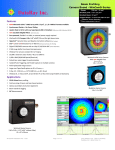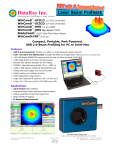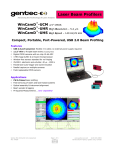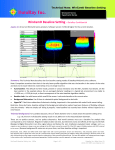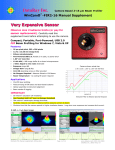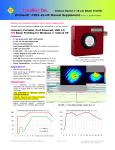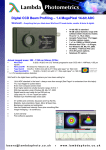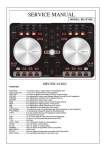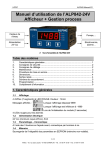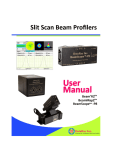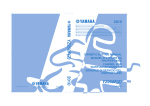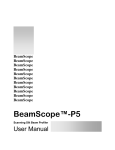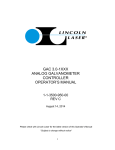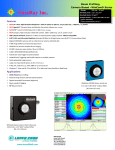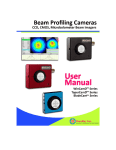Download Datasheet Dataray WincamD
Transcript
Beam Profiling Camera Based –WinCamD Series Features Range: NEW WinCamD‐LCM 1” CMOS array with 5.5 µm2, 1, 2, & 4 MPixel Formats available Smallest Beam: 32 µm** 190 nm - 16 µm* Smallest pixel: 3.2 x 3.2 µm* Imaged Areas*: 6.3 x 4.8 to 20 x 15 mm * Camera/ Sensor dependent **Direct measurement, see p. 3 Synchronous Shutter = No Comet Tailing Update Rate to 50 Hz with new SuperSpeed USB 3.0 interface (LCM series is USB 3.0 all others USB 2.0) New stackable MagND Filters (LCM series only) Port‐powered, flexible 3 m cable, no external power supply required. WinCamD‐LCM Compact 1.8 x 1.8 “ x 0.8” (20 mm) fits tight beam trains HyperCal™ Dynamic Noise and Baseline Correction software (Pat. Pending) CTE™ Comet Tail Elimination for λ> 900 nm (CCD based cameras), (Pat. Pending) Digital CCD/CMOS cameras with on‐chip 12/14/16‐bit ADC (camera dependent) 4 MB image buffer & on‐board microprocessor Window‐free sensors standard for no fringing 25,000:1 electronic auto‐shutter, 40 s to 1000 ms 1,000:1 SNR (30/60 dB Optical/Electrical) Pulsed laser auto‐trigger & synchronization Isolated Pulse Triggering and Parallel capture on multiple cameras Field‐replaceable image sensors Large area TaperCamD options to 20 x 15 mm (p.7) WinCamD‐LCM Series Camera With new MagND Filter X‐Ray, UV, 1310 nm (p.8), 1475‐1680 nm (p.10) & 2‐16 µm Shown actual size Windows 8, 7, Vista and XP, 32 and 64 bit. PC or Mac‐Intel using Parallels or BootCamp. LCM‐series run on Windows 8 and 7, 64 bit only. 1.8 x 1.8 x 0.8” Applications CW & Pulsed laser profiling Field servicing of lasers and laser‐based systems Optical assembly & instrument alignment Beam wander & logging M 2 Measurements WinCamD Series Camera 2.40 x 2.65 x 1.12” (x0.9” without filter) 61 x 67 x 28 mm BladeCam Series Camera 1.8 x 1.8 x .065” www.dataray.com (203) 210-5065) New ‐ More Powerful Beam Analysis Software Log profile displays, no averaging. Without HyperCal™ With HyperCal™ 0.3% noise + baseline tilt Noise <0.1% & flat baseline Auto‐Inclusion Region on an Elliptical Beam Automatically isolates the appropriate analysis region. With user overrides and multi‐beam features. With 1064 nm Comet Tail With CTE™ CTE™ Comet Tail Elimination @ λ> 900 nm Standard Linear Profile with Gaussian Fit. Logarithmic Profile shows more detail near baseline The same profile with Averaging & Log 40 dB display reveals Beam Wander on a drifting Laser structure in the wings of the beam at levels below 1% Mean, RMS and Max. deviation. Replay Fast or Slow. Export to Excel, Paint, Bitmap or Clipboard. Page 2 of 11 Up to 8192 samples at a User Set interval. DataRay Innovation ‐ The company that brought you the first Windows‐based CCD beam profiler, the first Camera for confined spaces, the first software slider exposure and electronic auto‐shutter, the first standard window‐free CCD for no fringing, the first auto‐orientation on the ellipse & the first USB 2.0 beam profiling camera … has done it again now with our new USB 3.0 compact 1” format cameras. Compact WinCamD cameras: Fully featured cameras small enough to fit in your shirt pocket, or to fit in a space 0.65” thick (BladeCam). Features: Digital serial link for EMI immunity XY profiles and centroids Linear and logarithmic displays Gaussian and Top Hat least squares fits Ellipse Angle, Major, Minor, Mean Diameters WinCamD‐CCD & CMOS Sensor Specifications: WinCamD™ Pixel Count & H x V: Sensor image area (mm): Pixel dimension (µm): Min. beam (10 pixels): Shutter type: Max. full frame rate: Max. ‘every pulse’ PRR: Single pulse capture PRR: Signal to RMS Noise: Opt./Elec.* dB: Electronic Shutter Dynamic Range: ND+Shutter+SNR Dynamic Range**: TaperCamD‐UCD12 pixel size: TaperCamD‐UCD20‐15 Pixel size: ADC: Interface: ‐LCM4 Background capture and subtraction Image & Intensity Zoom Linear and area filters Image Averaging, 1 to continuous Compact design 0.65” Probe style for tight applications ‐LCM2 ‐LCM1 4 M Pixel 2048 x 2048 11.3 x 11.3 5.5 x 5.5 55 µm Synchronous >15 Hz 10 Hz 18 Hz 1,000:1 60 dB 63 dB 113 dB** 2.1011:1 NA 15 x 15 2 M Pixel 1600 x 1200 8.8 x 6.6 5.5 x 5.5 55 µm Synchronous >30 Hz >30 Hz 18 Hz 1,000:1 60 dB 63 dB 113 dB** 2.1011:1 NA NA 1 M Pixel 1024 x 1024 11.3 x 11.3 11 x 11 110 µm Synchronous >30 Hz >30 Hz 18 Hz 1,000:1 60 dB 63 dB 113 dB** 2.1011:1 NA NA 12/ 10 bit USB 3.0 12/ 10 bit USB 3.0 12/ 10 bit USB 3.0 ‐UCD12 1.4 M Pixel 1360 x1024 6.3 x 4.8 4.65 x 4.65 ~47 µm Synchronous ~5‐10 Hz ~5‐10 Hz 20 kHz 1,000:1 30/60* dB 44 dB 113 dB** 2.1011:1 11 x 11 m NA ‐UCD15 ‐UCD23 ‐HR*** ‐XHR*** ‐FIR2‐16‐HR 1.9 M Pixel 1600 x 1200 7.1 x 5.4 4.4 x 4.4 ~44 m Synchronous ~5‐10 Hz ~5‐10 Hz 20 kHz 1,000:1 30/60* dB 44 dB 113 dB** 1.6 11:1 NA NA 1.4 M Pixel 1360 x1024 1.3 M Pixel 1280 x 1024 3.1 M Pixel 2048 x 1536 308 k Pixel 640 x 480 8.8 x 6.6 6.45 x 6.45 ~65 µm Synchronous ~5‐10 Hz ~5‐10 Hz 20 kHz 1,000:1 30/60* dB 44 dB 113 dB** 2.1011:1 NA 6.6 x 5.3 5.2 x 5.2 ~52 m Rolling ~5‐10 Hz NA 20 kHz 1000:1 30/60* dB 44 dB 113 dB** 2.10.1011:1 NA NA 6.5 x 4.9 3.2 x 3.2 ~32 m Rolling ~5‐10 Hz NA 20 kHz 1000:1 30/60* dB 44 dB 113 dB** 2.10.1011:1 NA NA 10.9 x 8.2 17 x 17 ~170 µm Sampled Array 9 Hz NA NA >100:1 >20/40* dB 9 dB Call Call NA NA 10‐bit USB 2.0 10‐bit USB 2.0 12‐bit USB 2.0 14‐bit USB 2.0 16‐bit USB 2.0 15 x 15 m 14‐bit USB 2.0 *OK, we agree that quoting electrical dB for optical SNR is nonsense, but some suppliers do this, so we offer a comparable specification. ** OK, we agree that Dynamic Range that includes removable ND filters is also nonsense, but some suppliers do this, so we offer comparable specification with ND *** Available in both BladeCam™ and WinCamD™ housings Common WinCamD/BladeCam Series Specifications: [Specifications are subject to change without notice] Wavelength: Standard ‐1310 ‐NIR ‐FIR2‐16HR ‐UV High dynamic range to 113 dB electronic (see notation under chart**) ~350 to 1150 nm ~350 to 1330 nm. Residual silicon response. 1290 nm long‐pass filter and light guard tube provided. ~1480 to 1680 nm. NIR to Visible conversion phosphor (Erbium response), 40 m FWHM Point Spread Function ~2 to 16 and 17 µm pixel pitch, 640 x 480 pixels, 10.9 x 8.2 mm (WinCamD‐FIR2‐16‐HR) ~190 to 1150 nm UV converters with wavelength options down to X‐ray. UV resolution to 1m. 25,000:1 (44 dB) continuously variable auto electronic shutter, <40 s to 1.0 s. Additional 10,000:1 ND filter + 5:1 electronic control to give 109:1. Pulsed lasers Auto‐trigger sync, TTL input trigger, TTL output trigger Interface Port Powered USB 2.0 for laptops & desktops. 3 m standard thin cable, 5 m option. USB 3.0 compatible Multiple Heads: 1 – 8 cameras. Parallel capture, serial read. ISO 11146 Beam profile Second moment processing Certification RoHS, WEEE, CE Measurable Sources CW beams, Pulsed sources. CW to 25 kHz with single pulse isolation, user configurable Synchronous, Asynchronous & Variable Delay trigger options. Software programmable trigger input, +ve or –ve edge, 2 k impedance Measured Beam Powers Manual Beam Attenuation: Options: Measurement Accuracy See the Saturation Beam Power/Pulse Energy Graph and Notes, below. Provided ND 4.0 (10,000:1) C‐mount Neutral Density filters. [ND 4.0 at 546 nm, higher in blue, lower in near IR.] Screw stackable ND 0.5, 1, 2, 3, 4, 5 available. EAM‐2: 4‐wheel stepped variable attenuator, 0 to 90 dB CUB and CUB‐UV 3 to 10 %, 30 arc minute wedge samplers for high power beams 0.1 m processing resolution for interpolated diameters. Absolute accuracy is beam profile dependent – ~1 m accuracy is frequently achievable. Centroid accuracy is also beam dependent. It can be as good as ±1 m since it is arithmetically derived from all pixels above the centroid clip level. Page 3 of 11 Measured & Displayed Profile Parameters Beam Diameter: Diameter at two user set Clip levels Gaussian & Second Moment beam diameters Equivalent diameter above a user defined Clip level Equivalent Slit and Knife Edge diameters Beam Fit: Gaussian & Top Hat profile fit & % fit Equivalent Slit profile Ellipticity: Major, Minor & Mean diameters. Auto‐orientation of axes. Centroid Position: Relative and absolute Intensity Weighted Centroid and Geometric Center Beam Wander Display and Statistics Smoothing Filter: Triangular running filter up to 10% FWHM Displayed Profiles & Plots X‐Y Profiles, 2D, 3D Plots. Zoom to x10 10, 32, 16,384 or colors or gray scale. Contoured display at 10 and 32 color. Processing Options HyperCal™ Real‐time electronic baseline correction CTE™ Comet Tail Elimination Image & profile averaging, 1, 5, 10, 20, Continuous Background Capture and Subtraction User set Capture Block option *.job files save all WinCamD custom settings for particular test configurations Pass/Fail display Log data and statistics On‐screen, in selectable Pass/Fail colors. Ideal for QA & Production. Min., Max., Mean, Standard Deviation. Up to 4096 samples Relative Power Measurement Fluence Rolling histogram based on user’s initial input. Units of mW, µJ, dBm, % or user choice (relative to a reference measurement input) Fluence, within user defined area Chip depth from front of case /filter ring all ±~0.2 mm LCM Series WinCamD‐UCD12 WinCamD‐UCD15 WinCamD‐UHR/ XHR WinCamD‐UCD23 BladeCam‐HR/ XHR (current, verify with factory) 5.7 / 10.7 mm (12.05 mm with MagND) 8.6 / 13.1 mm 5.7/ 10.2 mm 8.5/ 13.0 mm 8.0 / 12.5 mm 5.0/ 9.5 mm Outline and Mounting W x H x D See Drawings Below WinCamD‐LCM 1.8 x 1.8 x 0.81” WinCamD‐Series 2.65 x 2.4 x 0.9” BladeCam‐HR/ XHR 1.8 x 1.8 x 0.45” (46 x 46x 20.7 mm) (67 x 61 x 23/29 mm) (46 x 46 x 11.5/16.5 mm) Camera Head Weight WinCamD 155 gm (5.5 oz); BladeCam‐ 42.5 grams (1.5 oz) MagND Filter adds 0.25” (6.35mm) only LCM series C‐mount ND Filter adds 0.2” (5mm) C‐mount ND Filter adds 0.2” (5mm) Minimum Computer Requirements: 2 GHz processor or higher running Windows 7/ Vista/XP, 32 or 64‐bit; 2 GB RAM; 200 MB Hard Drive space; 1024 x 768 monitor, Standard USB 2.0 hi‐power (500 mA) port or USB 3.0 port. LCM series require Windows 8, 7, 64 bit only. PC or Intel‐Mac Outline and Mounting (shown actual size) WinCamD‐LCM Series With new MagND filter Page 4 of 11 WinCamD series with c‐mount ND filter Saturation Beam Power/ Pulse Energy Graphs These two graphs allow you to simply determine the approximate maximum CW optical power (above) or pulse energy (below) that the standard WinCamD/BladeCam configuration can measure for your beam diameter and wavelength without additional attenuation. The Saturation Limit assumes: ‐ The provided ND 4.0 filter in place ‐ The electronic shutter set at 40 s, its lowest value ‐ The ADC gain set at 1, its lowest value ‐ The beam onto the ND filter must not exceed 2.5 x (Beam diam. in mm) W, or 10 W total power for large beams. 400 nm 500 nm 1064 nm 675 nm 800 nm 400 nm 500 nm 1064 nm 675 nm 800 nm Relative Exposure vs. Wavelength 100 The lower limit in the standard configuration is ~10‐5 x the Saturation Limit. 10 Use the graph right to estimate for other wavelengths. 1 300 500 700 Wavelength in nm Page 5 of 11 900 1100 ORDERING INFORMATION 3 Year Warranty Free Software Upgrades 30 Day Sale or Return Evaluation PO A Complete System comprises: USB 3.0/ 2.0 Camera, ND 1, 2 & 4.0 filters, Software, 3 m (10 ft) Cable, User Manual. Generate the Part Number based upon the component descriptions, and limitations, in the table. Your CCD or CMOS chip choice does not affect the system price, except for the –UCD15 & ‐UCD23 CCD chips which cost more. Camera type + Part Number = BladeCam CCD/CMOS chip + Suffix (if required) ‐HR/‐XHR ‐UV/‐1310/‐NIR WinCamD ‐LCM4/‐LCM2/‐LCM1 ‐UV/‐1310/‐NIR ‐UCD12/‐UCD15/ ‐UCD23/‐UHR/‐XHR TaperCamD20‐15 ‐UCD23 ‐1310/‐NIR e.g. WinCamD‐UCD12 is a complete working system with a High Resolution CCD sensor with 4.65 m pixels. TaperCamD‐1310 is a complete working system with a 14.4 x 10.8 mm FO Taper for 1310 nm. Part Number Descriptions WinCamD‐LCM4 1” CCD sensor for CW and pulsed, 2048 x 2408 pixels, 11.3 x 11.3 mm, 5.5 x 5.5 µm pixel WinCamD‐LCM2 ⅔” CCD sensor for CW and pulsed, 1600 x 1200 pixels, 8.8 x 6.6 mm, 5.5 x 5.5 µm pixel WinCamD‐LCM1 ½” CCD sensor for CW and pulsed, 1024 x 1024 pixels, 11.3 x 11.3 mm, 11.0 x 11.0 µm pixel WinCamD‐UCD12 ½” CCD sensor for CW and pulsed, 1360 x 1024 pixels, 6.3 x 4.8 mm, 4.65 x 4.65 µm pixel WinCamD‐UCD23 ⅔” CCD sensor for CW and pulsed, 1360 x 1024 pixels, 8.8 x 6.6 mm, 6.45 x 6.45 µm pixel WinCamD‐UCD15 1/1.8” CCD sensor for CW and pulsed, 1600 x 1200 pixels, 7.1 x 5.4 mm, 4.4 x 4.4 µm pixel BladeCam‐HR BladeCam‐XHR ½” CMOS sensor for CW and high PRR, 1280 x 1024 pixels, 6.6 x 5.3 mm, 5.2 x 5.2 µm pixel also available in WinCamD‐ WinCamD‐UHR ½” CMOS sensor for CW and high PRR, 2048 x 1536 pixels, 6.5 x 4.9 mm, 3.2 x 3.2 µm pixel also available in WinCamD‐ WinCamD‐XHR TaperCamD‐UCD12 WinCamD‐UCD12 with 14.4 x 10.8 mm 2.25:1 FO taper on the sensor TaperCamD20‐15‐UCD23 WinCamD‐UCD23 with 20 x 15 mm 2.27:1 FO taper on the sensor. ‐1310 Adds 50 mm C‐mount tube and long‐pass filter for 1290 to 1350 nm work. ‐UV Camera with 3 mm UG11 filter in addition to ND filters. Works at 260 through 1100 nm. ‐NIR On‐chip IR to visible phosphor converter for 1480 to 1605 nm. ‐FIR2‐16HR Complete IR camera for 2 to 16 µm Extra cameras are available at a reduced cost and come with Cable, Mount and ND filter, but no Software or User Manual. Confirm with factory. Add additional suffix ‐X to the system Part #. E.g.: WinCamD‐UHR becomes WinCamD‐UHR‐X Accessories EAM‐2 Variable Attenuator, 93 dB optical dynamic range. Max.: 1 W/cm2 ; 100 mJ/cm2. CUB & CUB‐UV Vis & UV Beam wedge splitters, 3% to 10% (polarization dependent) C‐mount to camera. ND0.5, ND1.0, ND2.0, ND3.0, Additional Neutral Density filters in ND 1 steps in stackable C‐mount threaded holders. (ND4.0 filter comes as standard with the ND4.0, ND5.0 system.). See User Manual for curves. (Add L after ND for use with TaperCamD20‐15, e.g. NDL3.0) M‐Squared Option for WinCamD – USB 2.0 M2DU‐WC WinCamD‐Series USB 2.0 M2 Scan: 2.5 µm steps, 44 mm travel add lens below. (Order Lens assembly separately) UV, VIS, NIR, FIR Focal lengths from 50 – 1000 mm Other DataRay Profiling Instruments BeamMap2 Real Time M‐Squared Multi‐plane profiler 0.1 µm resolution on CW lasers. Focus, Alignment, Divergence, M2, Visible and Telecom wavelengths, Dual Detector 190 nm to 2.4 µm. Beam’R2 0.1 µm sampling on CW lasers, 0.5 µm to 4 mm beam dimensions, Dual Detector 190 nm to 2.4 µm. BeamScope‐P8 100 µm to 23 mm, M2 accessory option, ISO 11146 Standard Linear scanning slit, CW or Pulsed (PRR >5 kHz) lasers, up to 23 x 45 mm scanned area, 190 nm to 1.8 µm. Page 6 of 11 TaperCamD for Direct Imaging of Larger Beams TaperCamD20‐15‐UCD23 series beam profiling cameras are unique to DataRay and offer a larger effective imager area. TaperCamD cameras offer direct imaging of the beam without any of the Gaussian beam near‐field/far‐field issues that arise with the use of beam expansion telescopes. They are available in standard, ‐1310 and –NIR versions. Fiber optic tapers are fused coherent fiber bundles, heated, drawn and polished to give an output end the size of the imager chip. The image is de‐ magnified (M<1) from the faceplate input to the imager chip end. The taper ends are bonded to the surface of the imager chip using a proprietary DataRay process which eliminates both surface reflections and thermal cycling stress. The PMF (Pixel Multiply Factor) shown below and on the camera label is entered into the software in order to provide correct diameter readings. NA at the imager end is 1.0. NA at the input faceplate is a factor of M smaller (0.45) light at higher angles will be attenuated. The individual fibers at the input end are 6 µm pitch with a 50% core/cladding area ratio. Refractive index is 1.81, leading to a front surface reflectivity of 8.3%. Residual distortion is specified by the manufacturer at ±3% barrel/pin‐cushion distortion. In our experience this distortion is concentrated towards the edges of the field. Residual non‐uniformity in optical response is generally small and requires no correction, but the ability to do so is available in the software. Empty filter holders are available for both TaperCamD sizes. A 0.25” deep extension ring is available with male and female 1.30”‐20 tpi threads. Imager area is shown actual size in mm for: 6.5 4.8 WinCamD-UCD12 BladeCam-HR/ XHR 10.88 8.2 8.04 6.86 5.4 7.1 11.3 11.3 6.6 8.8 WinCamD-FIR2-16HR WinCamD-UCD23 WinCam-UCD15 WinCamD-LCM4 11.3 x 11.3 mm WinCamD-LCM2 8.8 x 6.6 mm WinCamD-LCM1 11.3 x 11.3 mm 20 TaperCamD20-15-UCD23 15 TaperCamD20-15-UCD23, PMF = 2.27 Page 7 of 11 WinCamD‐XXXX‐1310: High Resolution beam profiling to 1350 nm. Image of a 1310 nm beam, 100 µm diameter, 1.5 mW. [43 ms Shutter, no ND filter] The high resolution advantage of 4.65 µm square pixels is clearly seen. (WinCamD‐UCD12) Summary: 1) Technology. WinCamD‐XXXX‐1310 uses proprietary software and electronics in conjunction with sensors that exhibit residual sensitivity at 1310 nm. This is a tailing silicon response, and has been observed out to at least 1340 nm. The effective Quantum Efficiency (QE) in this tailing response is around 0.01%, i.e. a factor of around ~104 down on the visible response. 2) Features. Despite the low QE, WinCamD‐XXXX‐1310 cameras can be very attractive for 1310 nm region use if the source irradiance is adequate (see later). The small 5.5/4.65 micron square pixels give much higher resolution than standard NIR cameras. The WinCamD shutter exposure of up to 1047 ms is 25 to 30 times greater than that of standard cameras, partially compensating the low 1310 nm sensitivity. 3) Operational Issues. ND filters are not normally used with WinCamD‐XXXX‐1310, unless the beam power is very high, meaning that normal laboratory background can dominate the 1310 nm signal. Options are: ‐ Use no filter and work in a darkened room, or with black screening ‐ Use a long pass filter which blocks radiation below the wavelength(s) of interest. DataRay supports both options. No Filter Operation. With no shading or filtering, a typical room background level is equivalent to an exposure time of ~3 ms. i.e. the background is ~10% of the signal when the exposure time with signal is ~0.3 ms. This emphasizes the need to suppress the ambient light as far as is possible. Working in a darkened lab is the best solution. The provided 50 mm long, 30 mm OD, black‐anodized C‐mount tube, reduces ambient lab background by a factor of around 4. A 100 mm long tube will reduce the ambient lab background by a factor of around 8. With thin black card and tape, you can mount your own custom tube off the provided 50 mm C‐mount extension, and customize the ambient suppression shading to your application. Page 8 of 11 Long‐Pass Filter Option. DataRay provides the WinCamD‐XXXX‐1310 camera with an angled, C‐mount WCD‐LPF1290 custom long pass filter, with ≥80% transmission above 1295 nm, 50% transmission at 1290 nm, 1% transmission at 1285 nm, fully blocked below 1250 nm. This filter provides very effective blocking of visible light, e.g. ambient light or laser pump signal. It has a custom construction to minimize fringing effects, but can still lead to some fringing due to internal reflections in the filter sandwich and between the filter rear surface and the CCD. Filters with lower cut‐on wavelengths can be obtained to special order. Exposure Time. Use the graph below to estimate the required exposure time for your beam. Maximum Beam Power. Note the red line indicating to the maximum power of 100 mW allowed on the CCD. Above this level, you must use sampling or attenuation to reduce the beam power. WinCamD/1310 Sensitivity Limits 100 (85% of ADC) Max Beam Power = 100 mW 10 Beam Power in mW 1 1 * 100 1,000 Exposure in ms For example, to give an 85% saturation level on the ADC: 0.1 At 1310 nm, a 100 micron diameter 2 mW beam will require a shutter exposure time of ~ 30 ms. 0.01 At < 1310 nm, will be lower. At > 1310 nm, will be greater. 10 0.001 10 100 1,000 Beam 13.5 % Diameter in microns Complete WinCamD‐XXX‐1310 system includes: WinCamD, WCD‐LPF1290 long pass filter, CM‐50 50 mm tube, 3 m cable, Software CD, User manual. Page 9 of 11 10,000 WinCamD‐NIR: Economical Telecom beam profiling, 1475 to 1605 nm WinCamD‐Series‐NIR & TaperCamD‐NIR for Telecom C & L bands 1475 to 1605 nm, IR to visible conversion phosphor on Silicon CCD ≈25 m FWHM point spread function due to phosphor ( ≈70 µm for CamIR Adapter) ±10% spatial response non‐uniformity due to phosphor ~20 W to 100 mW, for 1 mm diam. @1550 nm. (With 0.02% transmission (1550 nm) ND filter) Gamma: Signal = (Incident Irradiance) where γ =1.414. Gamma (γ) correction is included in the software. o e.g. 10 ms exposure on 1 mW, 1 mm diameter beam at 1550 nm. CamIR Adapter with C‐mount 3.5:1 faceplate to sensor image reduction 46 mm diam. x 97 mm long Page 10 of 11 NEW WinCamD‐FIR2‐16HR Compact, Portable, Port‐Powered, USB 2.0 10.6 µm Beam Profiling for Windows 8, 7, XP & Vista, 32 or 64 bit operating systems Features 17 µm pixel pitch, 640 x 480 pixels, 10.9 mm x 8.2 mm 2 to 16 µm wavelength range microbolometer Port Powered USB 2.0; flexible 3 m cable, no power brick 12-bit ADC, 4 MB image buffer & on-board microprocessor 16 ms time constant No Chopper Measure Pulsed or CW Beams Room Temperature - no cooling required Applications CO2/FIR laser profiling Field servicing of CO2 lasers and laser-based systems Optical assembly & instrument alignment Beam wander & logging 2.40 x 2.65 x 2.05” (1.86” without filter) [61 x 67 x 52.15 mm] Compact, Room Temperature, Port Powered WinCamD-FIR cameras. Features: Digital serial link for EMI immunity XY profiles and centroids Linear and logarithmic displays Gaussian and Top Hat least squares fits Ellipse Angle, Major, Minor, Mean Diameters Background capture and subtraction Image & Intensity Zoom Linear and area filters Image Averaging, 1 to continuous PC Or Mac-Intel Operation WinCamD-FIR Specifications Wavelength Ranges ~2 to 16 µm Pulsed lasers pulse rep rates should be greater than 100 kHz Compact 2.40” x 2.65” x 2.05” [61 x 67 x 52.15 mm] Interface USB 2.0 for laptops & desktops, 3 m standard thin cable, 5 m option USB 3.0 compatible. ISO 11146 Beam profile Second moment processing Certification RoHS, WEEE, CE Measurable Sources CW beams, Pulsed sources: free-running, not triggerable; average pulses over the ≈ 20 ms exposure period or with frame averaging. Mean irradiance limits still apply. Measured Beam Powers Contact Application Engineer for options Manual Beam Attenuation: Contact Application Engineer for options Measurement Accuracy 5 m processing resolution for interpolated diameters. Absolute accuracy is beam profile dependent – ~35 m accuracy is frequently achievable. Centroid accuracy is also beam dependent. It can be as good as ±20 m since it is arithmetically derived from all pixels above the centroid clip level. D-A-CH Laser 2000 GmbH 82234 Wessling Tel. +49 8153 405-0 [email protected] www.laser2000.de France – Telecom Laser 2000 SAS 78860 St-N. l. Bretèche Tel. +33 1 30 80 00 60 [email protected] www.laser2000.fr Page 11 of 11 France – Photonic Laser 2000 SAS FR-33600 Pessac Tel. +33 5 57 10 92 80 [email protected] www.laser2000.fr Iberia Laser 2000 SAS 28034 Madrid Tel. +34 650 529 806 [email protected] www.laser2000.es Nordics Laser 2000 GmbH 112 51 Stockholm Tel. +46 8 555 36 235 [email protected] www.laser2000.se











